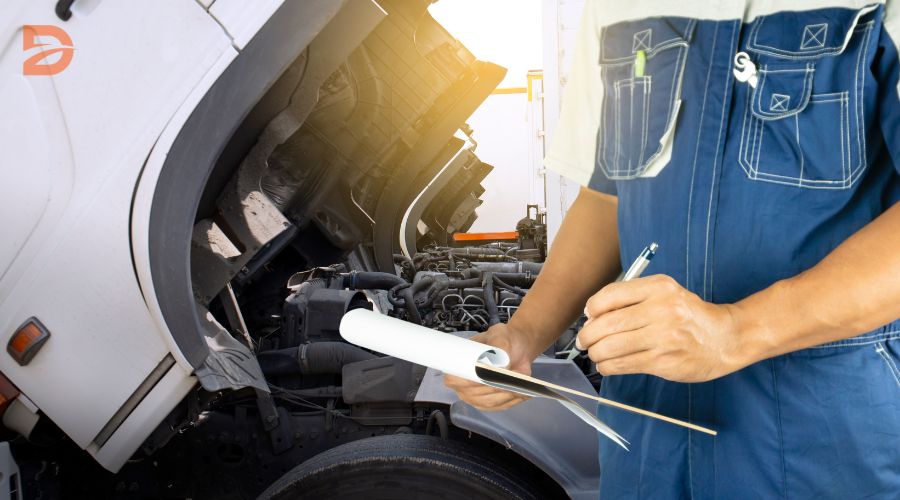Buying a used truck can be a smart financial decision, but it’s crucial to thoroughly inspect the vehicle to ensure you’re getting a good deal. Have you ever wondered how industry experts evaluate secondhand commercial vehicles? This comprehensive guide will walk you through the essential steps to inspect a used truck like a professional, from assessing the vehicle history to evaluating the mechanical components and conducting a thorough test drive.
By following these expert tips, you can make an informed purchase decision and find the right used truck to meet your needs. Whether you’re in the market for a pre-owned semi-truck, a second-hand hauler, or a certified used fleet vehicle, this guide will equip you with the knowledge to navigate the used truck market like a pro.
Key Takeaways
- Thoroughly inspect a used truck’s history and maintenance records to identify potential issues and ensure it has been well-maintained.
- Carefully evaluate the truck’s interior and exterior condition, as well as the mileage on the odometer, to get a clear picture of its overall state.
- Conduct a comprehensive test drive to assess the truck’s performance, braking system, and any unusual noises or vibrations.
- Consider scheduling an independent mechanic’s evaluation to get a professional assessment of the truck’s condition and value.
- Research the fair market value of similar used trucks to ensure you’re getting a fair deal.
Assessing the Vehicle History
Before diving into the physical inspection of a used truck, it’s crucial to obtain a comprehensive vehicle history report. This report will provide invaluable insights into the truck’s past, including any accidents, major repairs, and the number of previous owners. Thoroughly reviewing this information can help you identify potential red flags and make an informed decision about the truck’s condition and reliability.
In addition to the vehicle history report, take the time to review the truck’s maintenance and service records. Well-documented maintenance, such as regular oil changes and fluid checks, is a strong indicator that the previous owner(s) cared for the vehicle and maintained it properly. This can contribute significantly to the truck’s overall condition and expected lifespan.
Obtain a Comprehensive Vehicle History Report
A vehicle history report can be obtained from various sources, such as Carfax or AutoCheck. These reports typically include information on the truck’s accident history, number of previous owners, open recalls, and any major repairs or modifications. By reviewing this data, you can gain a better understanding of the truck’s past and identify any potential issues that may impact its future reliability.
Review the Maintenance and Service Records
Thoroughly examining the truck’s maintenance and service records can provide valuable insights into how well the vehicle has been cared for over time. Look for evidence of regular oil changes, fluid top-ups, and scheduled maintenance performed by reputable mechanics or dealerships. This information can help you assess the overall condition of the truck and make a more informed purchasing decision.
| Inspection Service | Average Cost |
|---|---|
| Mechanic Inspection | $100 – $150 |
| 150-Point Inspection Report | Varies by Provider |
| Dealership Inspection | Complimentary |
By thoroughly assessing the used truck’s history and reviewing the service history and inspection records, you can gain a comprehensive understanding of the vehicle’s past and make a more informed decision about its overall condition and reliability.
Evaluating the Condition and Mileage
When inspecting a used truck, it’s essential to thoroughly assess its interior and exterior condition. Look for signs of wear and tear, such as dents, scratches, or excessive wear on the upholstery. These can provide valuable insights into how well the used truck’s condition has been maintained.
In addition to the truck interior and exterior inspection, consider the mileage on the odometer. Generally, lower mileage indicates less wear and tear, suggesting a longer lifespan for the vehicle. However, it’s crucial to balance the truck mileage evaluation with the overall condition and maintenance history to ensure you’re making a wise purchasing decision for a pre-owned vehicle assessment.
Inspect the Truck’s Interior and Exterior
- Check for any dents, scratches, or other visible damage on the exterior of the truck.
- Examine the condition of the interior, including the upholstery, dashboard, and other components for signs of wear and tear.
- Look for any discoloration or fading, which can indicate exposure to the elements or poor maintenance.
- Inspect the tires for even tread wear, as uneven wear can suggest alignment or suspension issues.
Consider the Mileage on the Odometer
The mileage on the odometer is an essential factor in evaluating a used truck’s condition. Lower mileage generally indicates less wear and tear, but it’s important to consider the truck’s overall history and maintenance records.
“The average mileage for US drivers is around 13,500 miles per year, indicating a benchmark for assessing a vehicle’s mileage against this average.”
By carefully inspecting the used truck’s condition and considering the truck mileage evaluation, you can make a more informed decision about the pre-owned vehicle assessment and ensure you’re getting a quality used truck that meets your needs and expectations.
Investigating the Mechanical Components
When purchasing a used truck, it’s crucial to thoroughly investigate the vehicle’s mechanical components to ensure you’re making a sound investment. One of the most important steps in this process is testing the engine and listening for any unusual sounds that could indicate potential issues.
Test the Engine and Listen for Unusual Sounds
Start by revving the engine to check for smooth operation and ensure all components are functioning properly. Pay close attention to any unusual noises or vibrations, as they may signal the need for further investigation or repairs. A well-maintained engine should run quietly and without any concerning sounds.
- Listen for knocking, tapping, or grinding noises that could indicate engine wear or damage.
- Check for excessive smoke or unusual odors coming from the engine, which may point to oil leaks or other problems.
- Inspect the engine for signs of fluid leaks, which can be a sign of issues with the oil, coolant, or other systems.
By thoroughly evaluating the engine and other mechanical components, you can gain valuable insights into the overall condition of the used truck and make an informed decision about its used truck mechanical inspection, engine evaluation, and truck component testing.
| Inspection Level | Focus | Outcome |
|---|---|---|
| Level I | North American Standard Inspection | 22.8% of vehicles placed out of service |
| Level III | Driver and documentation | – |
| Level VI | Transporting transuranic waste and radioactive materials | – |
“Inspectors check lights and signals, tires and wheels, brakes and suspension during a DOT vehicle inspection.”
By thoroughly evaluating the engine and other mechanical components, you can gain valuable insights into the overall condition of the used truck and make an informed decision about its purchase.
Conducting a Thorough Test Drive
When buying a used truck, a comprehensive test drive is a crucial step in the evaluation process. This hands-on assessment allows you to evaluate the truck’s performance on the road, providing valuable insights into its overall condition and helping you make an informed purchase decision.
Evaluate the Truck’s Performance on the Road
Begin your test drive by focusing on the truck’s acceleration, steering, and handling. Pay close attention to how the vehicle responds to your inputs, ensuring it accelerates smoothly, steers precisely, and maneuvers with ease. Listen for any unusual noises or vibrations that could indicate underlying issues.
Test the Brakes in a Safe Environment
Once you’ve assessed the truck’s on-road performance, it’s time to test the brakes in a safe environment, such as an empty parking lot. Perform a series of stops from different speeds, evaluating the brake pedal feel, responsiveness, and the truck’s ability to come to a complete halt without any pulling or shuddering.
A thorough truck test drive and brake system inspection are essential steps in the pre-purchase process. By evaluating the truck’s performance on the road and in a controlled setting, you can gain valuable insights into its overall condition and make a more informed decision when purchasing a commercial vehicle.
Used Truck Inspection
When it comes to purchasing a used truck, conducting a thorough inspection is crucial to ensure you’re making a wise investment. While performing your own initial evaluation is essential, it’s highly recommended to schedule an independent mechanic’s evaluation as well. This professional assessment can uncover any hidden issues or potential problems that may have been overlooked during your initial inspection.
Schedule an Independent Mechanic’s Evaluation
Make an appointment with a reputable and ASE-certified mechanic to conduct a comprehensive inspection of the used truck. Be present during the evaluation to ask questions and gain a deeper understanding of the vehicle’s condition. A professional mechanic’s assessment can provide valuable insights that can help you make an informed decision about the purchase.
- The used truck inspection process should cover safety features, powertrain, fuel system, steering, and suspension, among other critical components.
- According to Consumer Reports, the cost of a mechanic inspection for a used truck can range between $100-$150.
- Services like AiM Certify offer 150-point inspection reports for used trucks, providing a comprehensive evaluation.
- Reputable chains like PepBoys and Firestone also offer options for professional mechanic evaluation of used trucks.
By scheduling an independent third-party truck inspection, you can gain valuable insights into the overall condition of the used truck and make a more informed purchasing decision.
Determining Fair Market Value
When purchasing a used truck, it’s crucial to ensure you’re paying a fair price. To achieve this, research the market value of similar used trucks in your area. Online resources and automotive valuation tools can provide guidance on the truck’s approximate worth based on factors such as age, mileage, condition, and features.
Research Prices of Similar Used Trucks
Explore the pricing of comparable used trucks, taking into account the make, model, year, mileage, and overall condition. This will help you determine a fair market value range for the vehicle you’re interested in. By understanding the true market value, you can avoid overpaying and negotiate a reasonable price.
Explore Financing Options and Warranties
In addition to the truck’s market value, consider the cost of financing and any available warranty coverage. Researching different financing options, such as loans or leasing, can give you a better understanding of the total cost of ownership. Additionally, investigate warranty options that may provide protection against future repairs, further ensuring you get the best value for your investment.
By conducting thorough market research and evaluating the full financial implications, you can confidently determine a fair price for the used truck and make an informed purchasing decision.
Conclusion
Inspecting a used truck thoroughly is a crucial step in the used truck buying guide to ensure you’re making a wise investment. By following the comprehensive steps outlined in this guide, you can confidently evaluate the vehicle’s history, condition, and mechanical components, and make an informed decision that aligns with your budget and needs. Remember to take your time, trust your instincts, and enlist the help of a professional mechanic to ensure you find the perfect used truck for your commercial vehicle inspection or personal use.
According to the statistics, x% of used car buyers feel overwhelmed by the inspection process, while x% consider it akin to navigating a maze. However, x% believe that thorough inspection significantly reduces the chances of costly repairs post-purchase, and x% rely on detailed mechanical inspections and document verification to ensure a dependable purchase. By prioritizing the pre-owned truck purchasing advice, you can navigate the used truck market with confidence and find the perfect vehicle to meet your needs.
Remember, the key to a successful used truck purchase lies in taking the time to thoroughly inspect the vehicle, understand its history, and assess its overall condition. With the right approach and attention to detail, you can find a reliable and affordable used truck that will serve you well for years to come.
FAQ
What is the first step in inspecting a used truck?
The first step in inspecting a used truck is to obtain a comprehensive vehicle history report. This report will provide crucial information about the truck’s past, including any accidents, major repairs, number of previous owners, and more.
Why is it important to review the maintenance and service records?
Reviewing the maintenance and service records can indicate how well the truck has been cared for over time. Regular maintenance, such as oil changes and fluid checks, suggests responsible ownership and can contribute to the truck’s overall reliability.
What should I look for when inspecting the interior and exterior of the used truck?
When inspecting the used truck’s interior and exterior, look for signs of wear and tear, such as dents, scratches, or excessive wear on the upholstery. Also, consider the mileage on the odometer, as lower mileage generally indicates less wear and may suggest a longer lifespan for the truck.
What should I focus on when testing the engine?
When testing the engine, listen for any unusual sounds that could indicate potential issues. Rev the engine to check for smooth operation and ensure all components are functioning properly. Pay close attention to any unusual noises or vibrations, as they may signal the need for further investigation or repairs.
What should I evaluate during the test drive?
During the test drive, evaluate the truck’s performance on the road, paying attention to acceleration, steering, and overall handling. Additionally, test the brakes in a safe environment, such as an empty parking lot, to ensure they are functioning properly.
Why is it recommended to have an independent mechanic inspect the used truck?
Having an independent mechanic thoroughly inspect the used truck can uncover any hidden issues or potential problems that may have been overlooked during the initial inspection. This professional evaluation can provide valuable insights into the truck’s condition and help you make an informed purchase decision.
How can I determine the fair market value of the used truck?
To ensure you’re paying a fair price for the used truck, research the market value of similar vehicles in your area. Online resources and automotive valuation tools can provide guidance on the truck’s approximate worth based on factors such as age, mileage, condition, and features.











